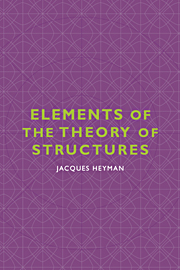Book contents
- Frontmatter
- Contents
- Preface
- 1 The theory of structures
- 2 Virtual work
- 3 Betti, Maxwell, Müller-Breslau, Melchers
- 4 Jettied construction
- 5 Clebsch, Macaulay, Wittrick, Lowe
- 6 The elastica
- 7 Mechanisms of collapse
- 8 The absolute minimum-weight design of frames
- 9 Inverse design of grillages
- 10 The relation between incremental and static plastic collapse
- 11 The bending of a beam of trapezoidal cross-section
- 12 The simple plastic bending of beams
- 13 Leaning walls; domes and fan vaults; the error function ∫e−t2dt
- Bibliography
- Name index
- Subject index
9 - Inverse design of grillages
Published online by Cambridge University Press: 18 December 2009
- Frontmatter
- Contents
- Preface
- 1 The theory of structures
- 2 Virtual work
- 3 Betti, Maxwell, Müller-Breslau, Melchers
- 4 Jettied construction
- 5 Clebsch, Macaulay, Wittrick, Lowe
- 6 The elastica
- 7 Mechanisms of collapse
- 8 The absolute minimum-weight design of frames
- 9 Inverse design of grillages
- 10 The relation between incremental and static plastic collapse
- 11 The bending of a beam of trapezoidal cross-section
- 12 The simple plastic bending of beams
- 13 Leaning walls; domes and fan vaults; the error function ∫e−t2dt
- Bibliography
- Name index
- Subject index
Summary
A structure will in general be hyperstatic, so that its elastic analysis requires the simultaneous solution of all three of the master equations. A continuous beam, for example, may rest on several supports, and initially unknown redundant forces will act on the system. Such a beam may carry different loads in adjacent spans, and, as a consequence, the cross-section of the beam may well vary from span to span (while perhaps being prismatic within each span). There are no formal difficulties in the elastic calculations associated with this continuous beam; the loads, the section properties and the boundary conditions could be introduced into a computer program, for example, and the required results will be produced.
The design of such a beam, as opposed to its analysis, is not so straightforward; the section properties cannot be introduced numerically into the calculations, since it is precisely the determination of the section (or sections) of the beam which is the object of the design process. Design proceeds, in fact, by trial and error, whether this process is done manually or by computer. A guess is made of the cross-sectional properties of the members; an analysis is made to determine stresses and deflexions throughout the beam; and finally a check is made as to whether the criteria of strength and stiffness are satisfied.
In this trial-and-error process, one design variable can be allowed, namely a scale factor.
- Type
- Chapter
- Information
- Elements of the Theory of Structures , pp. 81 - 93Publisher: Cambridge University PressPrint publication year: 1996



